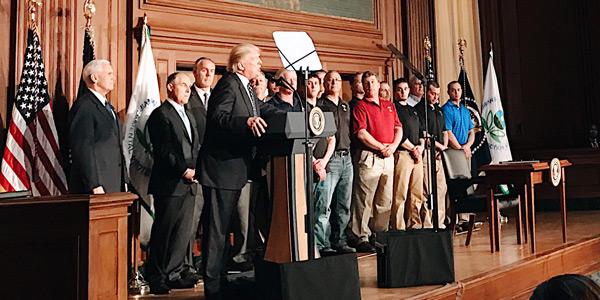By Rich Heidorn Jr. and Michael Brooks
WASHINGTON — President Trump signed an executive order Tuesday directing EPA to begin the lengthy process of undoing its Clean Power Plan, a centerpiece of American efforts to battle climate change.
Years of Litigation to Come?
The long-promised order, which directs EPA Administrator Scott Pruitt to immediately review and begin steps to rescind the CPP, is but the first step in a process that could take years. And it’s unclear if the effort will ultimately succeed.
The Supreme Court stayed the CPP in February 2016 pending a legal challenge by more than two dozen states that contended the rule overstepped EPA’s regulatory authority. The D.C. Circuit Court of Appeals heard arguments in the case in September. (See Analysis: No Knock Out Blow for Clean Power Plan Foes in Court Arguments.)
Shortly after Trump signed the order, the Justice Department filed a motion with the D.C. Circuit to hold the state challenge in abeyance while EPA reconsiders the plan. “The Clean Power Plan is under close scrutiny by the EPA, and the prior positions taken by the agency with respect to the rule do not necessarily reflect its ultimate conclusions,” the department said.
On Thursday, Pruitt sent a letter to state governors, telling them, “It is the policy of the Environmental Protection Agency that states have no obligation to spend resources to comply with a rule that has been stayed by the Supreme Court of the United States. To the extent any deadlines become relevant in the future, case law and past practice of the EPA supports the application of day-to-day tolling.”
Legal experts differ on whether the D.C. Circuit will dismiss the states’ challenge based on the Trump administration’s withdrawal of support. Environmental groups immediately promised to fight the reversal of the plan.
The challenge for the Trump administration is to kill the CPP without providing some alternative for controlling greenhouse gases. Under the 1946 Administrative Procedure Act, the federal rulemaking process cannot be “arbitrary and capricious.”
Thus, Trump’s order will put EPA officials in the odd position of having to contradict the findings the agency cited when it issued the final rule in August 2015, which incorporated feedback from 4.3 million comments and months of meetings with state regulators, utilities and RTO officials. (See Revised Clean Power Plan Allows More Time, Sets Higher Targets.)
The administration also will have to overcome the Supreme Court’s 2007 ruling in Massachusetts v. EPA that carbon dioxide is a pollutant that EPA must regulate under the Clean Air Act and the agency’s 2009 finding that greenhouse gases endanger public health.
According to a report in Politico, Pruitt successfully argued against attempting to reverse the agency’s endangerment finding, citing concerns it would be difficult to defend in a court challenge.
Myron Ebell of the Competitive Enterprise Institute and the former head of Trump’s EPA transition team, told Politico that leaving the endangerment finding in place would require EPA to come up with an alternative to the CPP for regulating power plant emissions. “Before you know it, you end up having to do a Trump Clean Power Plan,” he said.
Paris Agreement Threatened
Although the order does not indicate whether the U.S. will withdraw from the 2015 Paris Agreement on climate change, eliminating the CPP would make it far more difficult for the nation to meet its obligations to cut its carbon emissions to 26% below 2005 levels by 2025. The CPP requires a 32% reduction in power plant CO2 emissions from 2005 levels by 2030.
Economic consultancy company Rhodium Group estimates the U.S. would reduce carbon emissions by 21% below 2005 levels in 2025 under the CPP but that the reduction would flatten at 14% under Trump’s rollback.
The Paris Agreement is intended to prevent the planet’s temperature from increasing by more than 3.6 degrees Fahrenheit, which many experts say would lead to an irreversible future of rising oceans and extreme weather, leading to drought, flooding, and food and water shortages.
Social Cost of Carbon
Trump’s order requires federal agencies to use “the best available science and economics” in their cost-benefit analyses of regulations. But it also disbands the Interagency Working Group on Social Cost of Greenhouse Gases, created by the Council of Economic Advisers and the Office of Management and Budget in 2009, and dismisses the group’s work products as “no longer representative of governmental policy.”
Instead, it orders that “when monetizing the value of changes in greenhouse gas emissions resulting from regulations,” agencies rely on a 2003 Bush-era finding by OMB.
“In sum, to make a calculation based on ‘the best available science,’ they’re reverting to 2003 data,” wrote astrophysicist turned science writer Ramin Skibba in Slate.
The working group’s current SCC price of $36/ton has been widely criticized as too low, with some scientists contending it should be as high as $220/ton.
The OMB circular that Trump’s executive order cites suggests using a 7% discount rate for valuing future impacts of carbon emissions, more than twice the Obama administration’s rate of 3%. The higher discount rate is likely to reduce the SCC further.
Trump’s “plan would return the calculation to its 2003 level — a time when regulators could get away with ignoring climate costs and the benefits to avoiding them because of how uncertain they were,” Skibba said. “The main effect will be on proposed policies; for example, the next time [Department of Transportation] or EPA officials evaluate the fuel economy standards of cars and trucks, they wouldn’t have to set such strict limits. Eventually there will be more heavily polluting vehicles on the road, less efficient appliances in the marketplace, etc.”





